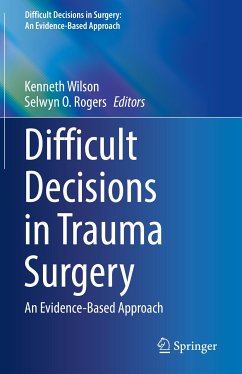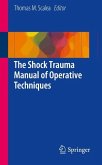Difficult Decisions in Trauma Surgery (eBook, PDF)
An Evidence-Based Approach
Redaktion: Wilson, Kenneth; Rogers, Selwyn O.


Alle Infos zum eBook verschenken

Difficult Decisions in Trauma Surgery (eBook, PDF)
An Evidence-Based Approach
Redaktion: Wilson, Kenneth; Rogers, Selwyn O.
- Format: PDF
- Merkliste
- Auf die Merkliste
- Bewerten Bewerten
- Teilen
- Produkt teilen
- Produkterinnerung
- Produkterinnerung

Hier können Sie sich einloggen

Bitte loggen Sie sich zunächst in Ihr Kundenkonto ein oder registrieren Sie sich bei bücher.de, um das eBook-Abo tolino select nutzen zu können.
This book provides a practical guide to decision making within the realm of trauma surgery. Each chapter covers the ideal approach, rather than customary care, for the treatment of the chosen difficult decision or controversy. A broad range of topics are covered with particular attention given to resuscitation, wound management, thoracic and abdominal trauma, antimicrobial management, transplant considerations, vascular trauma, traumatic brain injury, pediatric trauma and ethics. Difficult Decisions in Trauma Surgery aims to help improve the treatment of trauma patients and is relevant to…mehr
- Geräte: PC
- ohne Kopierschutz
- eBook Hilfe
- Größe: 7.29MB
![The Shock Trauma Manual of Operative Techniques (eBook, PDF) The Shock Trauma Manual of Operative Techniques (eBook, PDF)]() The Shock Trauma Manual of Operative Techniques (eBook, PDF)97,95 €
The Shock Trauma Manual of Operative Techniques (eBook, PDF)97,95 €![Pediatric Trauma Care (eBook, PDF) Pediatric Trauma Care (eBook, PDF)]() Pediatric Trauma Care (eBook, PDF)121,95 €
Pediatric Trauma Care (eBook, PDF)121,95 €![Difficult Decisions in Cardiothoracic Critical Care Surgery (eBook, PDF) Difficult Decisions in Cardiothoracic Critical Care Surgery (eBook, PDF)]() Difficult Decisions in Cardiothoracic Critical Care Surgery (eBook, PDF)129,95 €
Difficult Decisions in Cardiothoracic Critical Care Surgery (eBook, PDF)129,95 €![Difficult Decisions in Colorectal Surgery (eBook, PDF) Difficult Decisions in Colorectal Surgery (eBook, PDF)]() Difficult Decisions in Colorectal Surgery (eBook, PDF)113,95 €
Difficult Decisions in Colorectal Surgery (eBook, PDF)113,95 €![The Shock Trauma Manual of Operative Techniques (eBook, PDF) The Shock Trauma Manual of Operative Techniques (eBook, PDF)]() The Shock Trauma Manual of Operative Techniques (eBook, PDF)97,95 €
The Shock Trauma Manual of Operative Techniques (eBook, PDF)97,95 €![General Trauma Care and Related Aspects (eBook, PDF) General Trauma Care and Related Aspects (eBook, PDF)]() General Trauma Care and Related Aspects (eBook, PDF)73,95 €
General Trauma Care and Related Aspects (eBook, PDF)73,95 €![Difficult Decisions in Vascular Surgery (eBook, PDF) Difficult Decisions in Vascular Surgery (eBook, PDF)]() Difficult Decisions in Vascular Surgery (eBook, PDF)113,95 €
Difficult Decisions in Vascular Surgery (eBook, PDF)113,95 €-
-
-
Dieser Download kann aus rechtlichen Gründen nur mit Rechnungsadresse in A, B, BG, CY, CZ, D, DK, EW, E, FIN, F, GR, HR, H, IRL, I, LT, L, LR, M, NL, PL, P, R, S, SLO, SK ausgeliefert werden.
- Produktdetails
- Verlag: Springer International Publishing
- Seitenzahl: 459
- Erscheinungstermin: 29. Oktober 2021
- Englisch
- ISBN-13: 9783030816674
- Artikelnr.: 62857622
- Verlag: Springer International Publishing
- Seitenzahl: 459
- Erscheinungstermin: 29. Oktober 2021
- Englisch
- ISBN-13: 9783030816674
- Artikelnr.: 62857622
- Herstellerkennzeichnung Die Herstellerinformationen sind derzeit nicht verfügbar.







